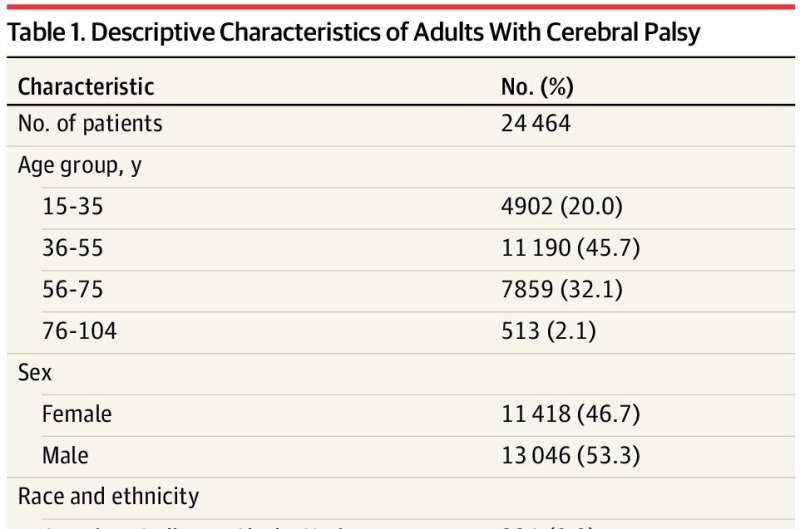
Descriptive characteristics of adults with cerebral palsy. Image credit: JAMA Neurology (2024). DOI: 10.1001/jamaneurol.2024.2443
Pain management is an important component of care for adults with cerebral palsy, but it is the least understood comorbidity in adults with cerebral palsy.
A study led by Mark Peterson, Ph.D., MS, FACSM, professor of physical medicine and rehabilitation at the University of Michigan Health, found that pain is very common in adults with cerebral palsy. 90% had a history of pain and 74% had multiple pain diagnoses from different sources, such as low back, irritable bowel syndrome, joint arthritis, and chronic headaches.
The research was published in the journal JAMA Neurology.
The study compared the prevalence of nociplastic, neuropathic, nociceptive and mixed pain subtypes in adults with cerebral palsy.
The data describe combinations of pain subtypes and assess their relationship to CP subtypes.
The distribution of pain phenotypes across categories showed that 86.3% of adults with cerebral palsy had nociceptive pain, 45.8% had nociplastic pain, and 16.9% had neuropathic pain.
Data for the research were collected from 2008 to 2020 from a 20% random sample of patients with a CP diagnosis over 18 years of age in the identifiable Medicare fee-for-service research files.
“The extremely high prevalence of pain and pain multimorbidity did not surprise us, as this is consistent with what most patients report,” Peterson said.
“However, this research shows a much higher prevalence of pain than previous research. We believe our data more accurately reflect the actual pain experience of adults with cerebral palsy.”
With their study, Peterson and his team hope to shed light on the significance of chronic pain in adults with cerebral palsy in order to develop better pain management techniques.
“Many adults with cerebral palsy are prescribed opioid medications to manage pain,” Peterson said.
“This is not sustainable in the long term and can cause numerous complications for patients. It is important to better understand the pain experienced by adults with cerebral palsy and how to manage this pain so that we can develop better treatments.”
“Pain is definitely the most common complaint in our clinic for adults with cerebral palsy,” said Edward A. Hurvitz, MD, professor of physical medicine and rehabilitation and co-author of the study.
“Accurate identification of the type and source of pain is critical for appropriate treatment.”
More information:
Mark D. Peterson et al, Pain phenotypes and pain multimorbidity in Medicare beneficiaries with cerebral palsy, JAMA Neurology (2024). DOI: 10.1001/jamaneurol.2024.2443
Provided by the University of Michigan
Quote: Better understanding of pain types in cerebral palsy could lead to better treatment (August 7, 2024), accessed August 7, 2024 from https://medicalxpress.com/news/2024-08-cerebral-palsy-pain-treatment.html
This document is subject to copyright. Except for the purposes of private study or research, no part of it may be reproduced without written permission. The contents are for information purposes only.

